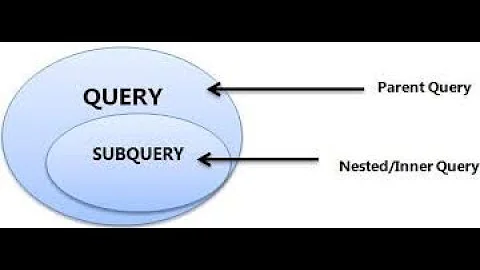MySQL DELETE FROM with subquery as condition
Solution 1
You cannot specify target table for delete.
A workaround
create table term_hierarchy_backup (tid int(10)); <- check data type
insert into term_hierarchy_backup
SELECT DISTINCT(th1.tid)
FROM term_hierarchy AS th1
INNER JOIN term_hierarchy AS th2 ON (th1.tid = th2.tid AND th2.parent != 1015)
WHERE th1.parent = 1015;
DELETE FROM term_hierarchy AS th
WHERE th.parent = 1015 AND th.tid IN (select tid from term_hierarchy_backup);
Solution 2
For others that find this question looking to delete while using a subquery, I leave you this example for outsmarting MySQL (even if some people seem to think it cannot be done):
DELETE e.*
FROM tableE e
WHERE id IN (SELECT id
FROM tableE
WHERE arg = 1 AND foo = 'bar');
will give you an error:
ERROR 1093 (HY000): You can't specify target table 'e' for update in FROM clause
However this query:
DELETE e.*
FROM tableE e
WHERE id IN (SELECT id
FROM (SELECT id
FROM tableE
WHERE arg = 1 AND foo = 'bar') x);
will work just fine:
Query OK, 1 row affected (3.91 sec)
Wrap your subquery up in an additional subquery (here named x) and MySQL will happily do what you ask.
Solution 3
The alias should be included after the DELETE keyword:
DELETE th
FROM term_hierarchy AS th
WHERE th.parent = 1015 AND th.tid IN
(
SELECT DISTINCT(th1.tid)
FROM term_hierarchy AS th1
INNER JOIN term_hierarchy AS th2 ON (th1.tid = th2.tid AND th2.parent != 1015)
WHERE th1.parent = 1015
);
Solution 4
You need to refer to the alias again in the delete statement, like:
DELETE th FROM term_hierarchy AS th
....
As outlined here in MySQL docs.
Solution 5
I approached this in a slightly different way and it worked for me;
I needed to remove secure_links from my table that referenced the conditions table where there were no longer any condition rows left. A housekeeping script basically. This gave me the error - You cannot specify target table for delete.
So looking here for inspiration I came up with the below query and it works just fine.
This is because it creates a temporary table sl1 that is used as the reference for the DELETE.
DELETE FROM `secure_links` WHERE `secure_links`.`link_id` IN
(
SELECT
`sl1`.`link_id`
FROM
(
SELECT
`sl2`.`link_id`
FROM
`secure_links` AS `sl2`
LEFT JOIN `conditions` ON `conditions`.`job` = `sl2`.`job`
WHERE
`sl2`.`action` = 'something' AND
`conditions`.`ref` IS NULL
) AS `sl1`
)
Works for me.
Related videos on Youtube
mikl
I am a web developer, open source enthusiast and a bit of a geek. I work for Docu Media, building web sites with Drupal and creating web applications with Node.js, Ember.js and the like. You can also check out my blog.
Updated on October 11, 2020Comments
-
mikl over 3 years
I am trying to do a query like this:
DELETE FROM term_hierarchy AS th WHERE th.parent = 1015 AND th.tid IN ( SELECT DISTINCT(th1.tid) FROM term_hierarchy AS th1 INNER JOIN term_hierarchy AS th2 ON (th1.tid = th2.tid AND th2.parent != 1015) WHERE th1.parent = 1015 );As you can probably tell, I want to delete the parent relation to 1015 if the same tid has other parents. However, that yields me a syntax error:
You have an error in your SQL syntax; check the manual that corresponds to your MySQL server version for the right syntax to use near 'AS th WHERE th.parent = 1015 AND th.tid IN ( SELECT DISTINCT(th1.tid) FROM ter' at line 1I have checked the documentation, and run the subquery by itself, and it all seems to check out. Can anyone figure out what's wrong here?
Update: As answered below, MySQL does not allow the table you're deleting from be used in a subquery for the condition.
-
 PiTheNumber almost 10 yearsAttention: Good answer at the bottom stackoverflow.com/a/4471359/956397 simply add the table alias after
PiTheNumber almost 10 yearsAttention: Good answer at the bottom stackoverflow.com/a/4471359/956397 simply add the table alias afterDELETE t FROM table t ...
-
-
 ajreal over 13 yearsis not about alias, please check the OP again
ajreal over 13 yearsis not about alias, please check the OP again -
JNK over 13 years@ajreal - I did, and please notice the error begins at the alias definition, and MySQL documentation explicitly states you need to use the alias in the DELETE statement as well as the FROM clause. Thanks for the downvote, though.
-
 ajreal over 13 yearssimply do this
ajreal over 13 yearssimply do thisdelete from your_table as t1 where t1.id in(select t2.id from your_table t2);what did you get ? -
Björn over 13 yearsThe documentation clearly states;
Currently, you cannot delete from a table and select from the same table in a subquery.dev.mysql.com/doc/refman/5.5/en/delete.html -
mikl over 13 yearsAh, as Björn says, it is impossible :( Fixing the alias thing just gives a different error: "You can't specify target table 'th' for update in FROM clause"
-
JNK over 13 years@mikl - Then you had two errors :) Fix the alias and use ajreal's workaround.
-
JNK over 13 yearswe are both right - see his comment to my answer below. Alias syntax and logic were both issues :)
-
mikl over 13 yearsYeah, seems deleting via subquery is not currently possible in MySQL – thanks for taking a look at it :)
-
 ajreal over 13 yearsyou don't have to fix the alias, just don't specify target table for selecting in delete ...this is the real problem
ajreal over 13 yearsyou don't have to fix the alias, just don't specify target table for selecting in delete ...this is the real problem -
 malhal over 12 yearsdoesn't the "DELETE FROM term_hierarchy AS th" in that last line have the same problem? I get a syntax error the same as the OP.
malhal over 12 yearsdoesn't the "DELETE FROM term_hierarchy AS th" in that last line have the same problem? I get a syntax error the same as the OP. -
Roman Newaza over 11 yearsYou should add Index to term_hierarchy_backup.tid.
-
 Tilman Hausherr about 11 yearsTook some time but I got it to work. Important: 1) The first table must be aliased as shown here with "e", 2) the "x" at the end is not a placeholder, it is the alias for the temp table produced by the subquery "(SELECT id FROM tableE WHERE arg = 1 AND foo = 'bar')".
Tilman Hausherr about 11 yearsTook some time but I got it to work. Important: 1) The first table must be aliased as shown here with "e", 2) the "x" at the end is not a placeholder, it is the alias for the temp table produced by the subquery "(SELECT id FROM tableE WHERE arg = 1 AND foo = 'bar')". -
usumoio over 10 yearsThis is a good answer. Proper Aliasing will go a long way to solve problems similar to the original post. (like Mine.)
-
donatJ about 10 yearsWhy does this work? This changes a lot for me, but moreover, it shouldn't work. It does work, but it shouldn't.
-
 Andrew Starlike about 10 yearsunbelievable. this actually works! but you are not forced to alias the table with e... you can use any alias you want.
Andrew Starlike about 10 yearsunbelievable. this actually works! but you are not forced to alias the table with e... you can use any alias you want. -
 CodeReaper almost 10 years@jakabadambalazs My reasoning when coming up with it, was that the subquery starting with "SELECT id" finishes and returns a list of ids and therefore releases the lock of the table you want to delete from.
CodeReaper almost 10 years@jakabadambalazs My reasoning when coming up with it, was that the subquery starting with "SELECT id" finishes and returns a list of ids and therefore releases the lock of the table you want to delete from. -
Steve Almond over 9 years@jakabadambalazs: We can't use the same table (
e) in a DELETE and in its sub-SELECT. We can, however use a sub-sub-SELECT to create a temporary table (x), and use that for the sub-SELECT. -
Sauron over 9 years@CodeReaper Correct me if I'm wrong, but do you think subquery failed because you did not put an alias on the first subquery? at line
WHERE arg = 1 AND foo = 'bar');should beWHERE arg = 1 AND foo = 'bar') 'alias letter'; -
txyoji over 7 yearsSteve Almond is correct. It creates a temp table. Run an explain plan on the delete statement and you'll see what I mean. dev.mysql.com/doc/refman/5.7/en/explain-output.html
-
Terry Lin about 7 yearsIncredible, it does work in my case.. even I don't know why
-
 Smith over 5 yearsCorrect - it works because the derived table is executed before the parent query - therefore there's no conflict in reading the table
Smith over 5 yearsCorrect - it works because the derived table is executed before the parent query - therefore there's no conflict in reading the table -
alpham8 over 4 yearsI am able to verify that, that it is neither possible in 2019 on MariaDB 10.3.14 or MySQL Community Server 5.7.27
-
jrypkahauer over 3 yearsThis is a brilliant solution... I was already starting to think along these lines and it saved me an hour or so trying to come up with it myself. Thank you so much! @donatJ - it is technically correct and indeed SHOULD work because the intermediate query DOES NOT SPECIFY A TABLE FROM WHICH TO SELECT THE VALUE, it just selects the id value from the subquery... therefore the original error no longer applies...
-
jrypkahauer over 3 yearsDuplicate of the one from @CodeReaper above... good call tho... ;)








